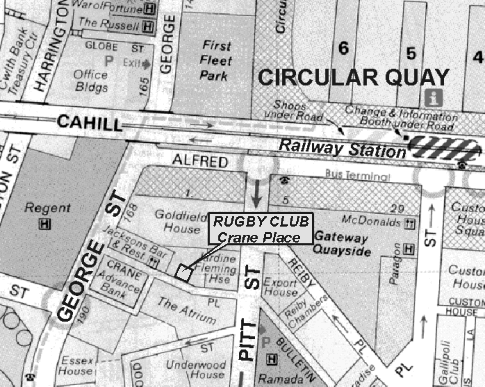
Rugby Club Location Map - Click to Enlarge
Click for a printable pdf flyer for this talk
DATE: Thursday 29th November, 2001. 5.30pm for 6pm
VENUE: Rugby Club, Rugby Place, Circular Quay
TOPIC: "Garnets, Diamonds, Diatremes and Subduction at Bingara, in the New England Orogen
of New South Wales, Australia"
(Image files below)
B. JANE BARRON 1, L.M. BARRON 2 AND G. DUNCAN 3
1 Consulting Petrologist, 7 Fairview Ave., St Ives, NSW 2075, Australia.
2 New South Wales Department of Mineral Resources PO BOX 536, St Leonards, NSW
2065, Australia.
3 Rimfire Pacific Mining NL, Level 13,379 Queen Street Brisbane, Queensland 4000,
Australia.
Corresponding author email: barronjl@optusnet.com.au
Abstract
At Bingara-Copeton, NSW Australia, alluvial diamond deposits are Cainozoic
'headless' placers in the Phanerozoic New England Orogen, more than 1500km distant
from the nearest craton. Recent studies have focussed on unusual calc-silicate eclogitic,
and mafic-eclogitic inclusions in the diamonds such as grossular garnet, clinopyroxene,
coesite, sphene, and molybdenite, with rare peridotitic inclusions of olivine, pentlandite
and chromite. In addition, their unique morphology and surface features suggest a local
origin.
Known age dates on some diamond inclusions are 340 ± 28Ma -early
Carboniferous; 326 Ma -mid Carboniferous; and 218 ± 6 Ma -late Triassic. Formation of
these non-cratonic mainly eclogitic metamorphic/metasomatic diamonds has been linked
to subduction, either through direct crystallisation within a downgoing slab, or through
more indirect mechanisms related to subduction. Here we link their origin to the well
documented Phanerozoic geology of the New England Orogen generated by prolonged
westerly subduction (associated with terrane accretion) from Ordovician, but particularly
during early Carboniferous to about mid-Triassic. Each subduction episode creates an
opportunity for trapping portions of a diamondiferous subduction slab within the
lithosphere by terminating subduction. There is also evidence for crustal doubling due to
tectonic underplating.
A variety of post subduction alkaline igneous rocks and many diatremes (several
reported as diamondiferous), as well as obducted blocks (mainly along the 1200km long
Peel-Yarrol Fault zone) could have delivered diamonds and related indicator minerals to
the surface. Abundant angular (proximal) garnet is widespread in the modern drainage
south of Bingara, and forms the most important "indicator"of eclogitic diamond that is
independent of ubiquitous diaggregated spinel lherzolite minerals from mantle xenoliths.
More than half of > 2000 microprobe analyses show that olivine, pyroxenes and
chromite (mainly related to spinel lherzolite) and some ilmenite lack indicator chemistry.
Major element chemistry of 960 garnets is assessed using the Schulze (1997) chemical
screen (based on eclogitic garnet chemistry from kimberlite and diamond exploration
programs, and regional indicator mineral surveys worldwide).
In terms of Ca-Mg-Fe the Bingara garnets, form a large population that ranges from
Cr-poor pyrope through Mg-rich almandine-pyrope to Fe-rich almandine and even Fe-Mn
almandine-spessartine compositions. There is a distinct break at 22 wt% FeO, splitting
the garnets into two main chemical groups; those from mantle eclogites (< 22wt% FeO)
and those from crustal sources (> 22wt% FeO + MnO). Na2O and TiO2 levels
discriminate a small, but well constrained Group I diamond eclogitic garnet population
from Cr-poor megacrysts and relatively lower pressure Group II eclogitic garnet. The
diamond eclogitic garnets are from three samples on basanite ?capped twin hills called
Tom and Jerry. About 2% of the garnets are crustal but have Na2O > 0.5 wt%. Rare
garnets of grossular composition also are present. Euhedral Ca-Fe-rich andradite garnets
form a separate but minor group.
Twenty four representative garnets were selected for trace- and HREE-element
chemistry. Results indicate both MORB and arc mafic protolith with dominantly
unfractionated patterns. The crustal garnets with elevated Na2O are highly enriched in
HREE and have strongly fractionated patterns that compare with garnets from leucocratic
orthogneiss within obducted UHP terranes. The REE patterns further suggest that the low
Cr-pyrope garnets are Mg-rich eclogite compositions derived from picritic oceanic
protolith, while the euhedral andradite garnets are related to hydrothermal alteration of
serpentinised dunite along the Peel Fault zone. The latter confirms a sparse ophiolitic
contribution to the Bingara samples.
Bingara garnet chemistry indicates a variety of igneous protoliths and
metamorphic grades, and proves that a high pressure- (HP) to ultrahigh- pressure (UHP)
eclogitic terrane at depth has been sampled by igneous intrusions, independent of the
ophiolite at the surface.
A single (0.265 carat) white diamond, recovered from the north-east slope of Tom
and Jerry, has the unique morphology and surface features of other stones from Copeton-
Bingara deep leads.
Therefore, the complex Phanerozoic tectonic history of subduction-accretion and
tectonic underplating in the New England region, together with garnet-based evidence
presented here for an extensive eclogitic to locally diamond eclogitic terrane with a
variety of protoliths at depth, strongly supports a local origin for the diamonds that
'belong' in this tectonic setting.

Rugby Club Location Map - Click to Enlarge